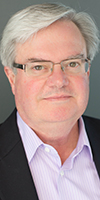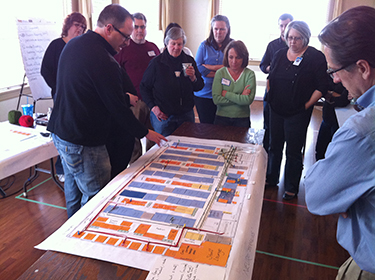|
Subscribe / Renew |
|
|
Contact Us |
|
| ► Subscribe to our Free Weekly Newsletter | |
| home | Welcome, sign in or click here to subscribe. | login |
Construction
| |
 |
July 23, 2015
The way we design health care projects is changing in a big way
CollinsWoerman

Giuntoli
|
Designing medical facilities well is a specialty that is earned with many years of experience. Just learning the language of our clients requires years of active listening.
Interpreting the goals of providers is an art, as often as much is left unsaid as is said openly. What we notice now is a shift in how we design these facilities. It is a subtle departure of a relatively accepted, standard process. The timing seems right.
It is understandable that the design process is changing just as the delivery of care and reimbursement structure is about to be dramatically altered.
Many of us who have designed health care facilities for a long time have incorporated user group design sessions as a basis for receiving input and affirming project direction. As I recall, this idea was first popularized by the architecture firm Caudill Rowlett Scott in their well-branded “Problem Seeking” approach to design. Their so-called “squatter sessions” were designed to get a local team of end users — physicians, staff, allied caregivers — in the room to develop the design concepts associated with their normal work processes.
Design events were often spread across several days during weekly forays, and the department-level meetings were quite siloed in their approach to input and reach. These events often carried through multiple phases of design and finalized in the identification of the most intimate detail.
Prior to this new process the architects were the experts. They listened generally to volume or scale assertions provided by the owner and developed a design based on their experience.
The architects used what had been successful solutions for them in the past as a basis of design. The Caudill Rowlett Scott approach capitalized on the disconnect between the architectural solution and medical operations personnel. They found that users who participated in the design process felt a greater degree of ownership, and therefore user group-driven design had less white noise associated with opening and startup.
Medical clients were willing to accept the disruption to their current operations, giving staff freedom to participate as a beneficial trade-off with improved employee acceptance.
A better process
It was 30 years before the process changed. User groups remained deeply involved. The difference was significant, however, as providers, staff and administrators began to realize that user group input wasn’t enough.
What if designs were being created in support of suboptimized work processes? In this new model great attention was given to optimized work processes and standard work.
The patient’s perspective became as important as the provider’s. User group design sessions were transformed into lean design events, modeled after the Toyota production method, with broad cross sections of horizontally and vertically stratified teams.
These events can often last four to five days. A major difference in this model is recognition that work flow transcends traditional departmental organization. While groups of users still huddle to give input and affirm direction, everyone would now be in the room together in the same meeting.
The challenge is not just to create a great space in support of the current patient flow, it is now to describe the best possible flow of patients, staff and materials, thus increasing throughput or enabling additional time with the patient. Handoffs became the enemy of process, and the most successful design solutions were often accompanied by a new look at who did what work tasks in the standard work process. A healthy overlay of the positive patient experience assisted in the destruction of silos in the best of solutions.
This approach remains very popular today. It does have its drawbacks.
It is incredibly labor intensive and requires extensive commitment of staff outside their normal jobs. What is more problematic, particularly for larger institutions, are that variability can still persist throughout the system if local delivery is allowed to design their own space around their own parochial local processes.
In this case can the design be optimized? Is best practice being elevated at a system level?
Lean gives way
For several reasons we are seeing lean user group sessions changing to prototype design and standards development. While lean remains embedded in the development of optimized standard work, it has given way to prototyping of best practice.
The goal is to create a system of standards that enhances predictability, speeds delivery to market and standardizes the best practice methodology the organization can muster. Recently we have worked with several of the Puget Sound region’s largest providers using facilitated workshops not just to design a facility, but to design standards that can be used to develop an entire delivery system.
The standards are designed for use at multiple scales. From entry to market retail facilities through large multispecialty centers, the standards make future development easier and capital planning more predictable. It should be noted, probably with no surprise, that the standards are focused exclusively on outpatient facilities.
During these prototyping sessions it is not just front line staff that is involved. It is the leadership of the organization that thinks through standard work and conceives of the spaces and work flows to be propagated. Except for the individuals in the room the sessions look much the same as the lean workshops of the earlier generation of design meetings.
Rather than a single facility focus, the focus is on the system and the system’s leadership develops the detail. The sessions are normally shorter. The involvement of key stakeholders can be broader or more narrow, dependent on the organizational culture. Perhaps ironically the process champions are often departments within organizations focused on real estate, not operations.
The architect is once again looked to as an expert. Rather than look to themselves as experts they turn to their design partner. The question most often asked at critical decision junctures: What is everybody else doing?
We are currently working on the next generation of design process with that question in mind.
CollinsWoerman Principal Phil Giuntoli has over 30 years of experience focused on the design of health care facilities.
Other Stories:
- Hospital addition zeroes in on better patient care
- High-tech lights can aid patients by mimicking the effects of nature
- What we’ve learned about making hospitals better for seniors
- It’s never too early to consider tech in your nursing home project
- Vacant big-box store finds new life as Children’s clinic
- New clinic at Swedish will treat patients who suffer from chronic pain
- Whidbey hospital’s hyper-efficient HVAC system may be the first of its kind here
- How a pharmacy was designed to limit exposure to toxic drugs
- Hospice brings comfort to dying patients



